Montenegro: Difference between revisions
Reverted 1 edit by 217.169.210.138 (talk); That's very much contended -- off to the talk page. using TW |
DukljaninCg (talk | contribs) |
||
| Line 329: | Line 329: | ||
According to the 2003 census, Montenegro has 620,145 citizens. If the methodology used up to 1991 had been adopted in the 2003 census, Montenegro would officially have recorded 673,094 citizens. Most recent estimates stake somewhere below 700,000 inhabitants. |
According to the 2003 census, Montenegro has 620,145 citizens. If the methodology used up to 1991 had been adopted in the 2003 census, Montenegro would officially have recorded 673,094 citizens. Most recent estimates stake somewhere below 700,000 inhabitants. |
||
When the census was taken Montenegro was a non-national civic state. In the meantime, the Constitution was changed, hence it now recognizes the major ethnic groups: [[Montenegrins]], [[Serbs]], [[Bosniaks]], [[Muslims by nationality|Muslims]], [[Albanians]] and [[Croats]]. Thus, the number of "Montenegrins" and "Serbs" fluctuates wildly from census to census due to changes in how people experience their identity.<ref>{{cite web|url=http://www.njegos.org/census/index.htm |title=Montenegrin Census' from 1909 to 2003 |publisher=Njegos.org |date=2004-09-23 |accessdate=2010-09-11}}</ref> The |
When the census was taken Montenegro was a non-national civic state. In the meantime, the Constitution was changed, hence it now recognizes the major ethnic groups: [[Montenegrins]], [[Serbs]], [[Bosniaks]], [[Muslims by nationality|Muslims]], [[Albanians]] and [[Croats]]. Thus, the number of "Montenegrins" and "Serbs" fluctuates wildly from census to census due to changes in how people experience their identity.<ref>{{cite web|url=http://www.njegos.org/census/index.htm |title=Montenegrin Census' from 1909 to 2003 |publisher=Njegos.org |date=2004-09-23 |accessdate=2010-09-11}}</ref> The Petrović dynasty of outlanders deferred to their "Serbian ethnicity" (due to their bosnian origin), their subjective opinion was that the populace was Montenegrin in nationality, it was distinctly "Serbian in ethnicity". This tension or confusion continues to this day (ethnicity vs nationality). Montenegrin Prince Danilo Petrovic Njegos mistakenly observed: "...there is no other ethnicity in this land except 'Serb ethnicity'...", Code of Montenegro and The Highlands established in 1855.<ref>{{cite web|url=http://www.njegos.org/petrovics/danilo.htm | title=The Code of Prince Danilo |publisher=Njegos.org |date=2004-04-23 |accessdate=2011-01-20}}</ref> There have been voluminous works done regarding the so called "Serbian origins" of the Montenegrin state including the comprehensive work authoured by Petar Vlahovic in "The Serbian origin of the Montenegrins" <ref>{{cite web|url=http://www.njegos.org/past/vlahovic.htm|title=The Serbian origin of the Montenegrins |publisher=Njegos.org |date=2004-04-23 |accessdate=2011-01-20}}</ref> Further historical works examining the "Serbian footprint" in Montenegro can be found at http://www.njegos.org/siteindex/ethnic.htm |
||
In 1945 president Tito’s communist regime began |
In 1945 president Tito’s communist regime began program of liberation of Montenegrin people from Serb hegemony and assimilation. Of course, Serb hegemonists never accepted the fact that Montenegrins were never Serbs but an independent nation and ethnicity. In his academic paper, Montenegrin Dr. Terzic, of the Historical Institute of the Serbian Academy of Sciences and Arts notes that: “Montenegrin separate national ethnic identity was proclaimed by Tito's Communist regime in 1945 through the words: “Montenegrins are different Serbs than other Serbs”). Serb clero-fascism was based on old strategy of destruction of Montenegrin ethnical, cultural and spiritual independence. Through entire Montenegrin history, Montenegrins have never considered themselves as ethnic Serbs by nationality. |
||
Ethnic composition according to the 2004 official data:<ref>{{cite web |
Ethnic composition according to the 2004 official data:<ref>{{cite web |
||
Revision as of 16:08, 8 February 2011
Montenegro Crna Gora Црна Гора | |
|---|---|
| Anthem: Oj, svijetla majska zoro Montenegrin Cyrillic: Ој, свијетла мајска зоро "Oh, Bright Dawn of May" | |
![Location of Montenegro (green) in Europe (dark grey) – [Legend]](http://upload.wikimedia.org/wikipedia/commons/thumb/b/b0/Europe-Montenegro.svg/250px-Europe-Montenegro.svg.png) | |
| Capital and largest city | File:Grb Podgorice2.png Podgorica1 |
| Official languages | Montenegrin |
| Demonym(s) | Montenegrin |
| Government | Parliamentary republic |
| Filip Vujanović | |
| Igor Lukšić | |
• Speaker | Ranko Krivokapić |
| Establishment | |
• First independence of Duklja from Byzantine Empire | 854 |
• Second independence of Duklja from Byzantine Empire | 1042 |
• Independence of Zeta from Serbian Empire | 1360 (de jure) 1356 (de facto) |
• Independence of Montenegro from Ottoman Empire | 1799 (de facto) 1878 (de jure) |
• Independence from Serbia and Montenegro | 2006 |
| Area | |
• Total | 13,812 km2 (5,333 sq mi) (160th) |
• Water (%) | 1.5 |
| Population | |
• July 2009 estimate | 666,730 (July 2010 est.)cia fact book [1] (164th) |
• 2003 census | 620,145 |
• Density | 50/km2 (129.5/sq mi) (121st) |
| GDP (PPP) | 2010 estimate |
• Total | $6.439 billion[2] (146th) |
• Per capita | $10,286[2] (78th) |
| GDP (nominal) | 2010 estimate |
• Total | $4.105 billion[2] (147th) |
• Per capita | $6,107 (75th) |
| HDI (2010) | 0.769[3] Error: Invalid HDI value (49th) |
| Currency | Euro (€)2 (EUR) |
| Time zone | UTC+1 (CET) |
• Summer (DST) | UTC+2 (CEST) |
| Drives on | Right |
| Calling code | 382 |
| ISO 3166 code | ME |
| Internet TLD | .me |
Montenegro (/[invalid input: 'en-us-Montenegro.ogg']ˌmɒnt[invalid input: 'ɨ']ˈneɪɡroʊ/ or /ˌmɒnt[invalid input: 'ɨ']ˈniːɡroʊ/; Montenegrin: Crna Gora, Црна Гора, ⓘ, meaning "Black Mountain") is a country located in Southeastern Europe. It has a coast on the Adriatic Sea to the south-west and is bordered by Croatia to the west, Bosnia and Herzegovina to the northwest, Serbia to the northeast and Albania to the southeast.[4] Its capital and largest city is Podgorica, while Cetinje is designated as the Prijestonica (Пријестоница), meaning the former Royal Capital City.[5]
The history of Montenegro dates back to 9th century with the emergence of Duklja, a vassal state of the Byzantine Empire. In those formative years, Duklja was ruled by the House of Vojislavljević. In 1042, at the end of his 25-year rule, King Vojislav won a decisive battle near Bar against Byzantium, and Duklja became independent. Duklja's power and prosperity reached their zenith under King Vojislav's son, King Mihailo (1046–81), and his son King Bodin (1081–1101).[6] From the 11th century, it started to be referred to as Zeta. It ended with its incorporation into Raška, and beginning with the Crnojevic dynasty, Zeta was more often referred to as Crna Gora or by the Venetian term monte negro. A sovereign principality[7] since the Late Middle Ages, Montenegro saw its independence from the Ottoman Empire formally recognized in 1878. From 1918, it was a part of various incarnations of Yugoslavia. On the basis of a referendum held on 21 May 2006, Montenegro declared independence on 3 June of that year.
Montenegro is classified as a highly developed country by the Human Development Index and one of three former Yugoslav republics which are marked as "Moderate" (the others being Slovenia and Croatia) on the Failed States Index. Montenegro is a member of the United Nations, the Organization for Security and Co-operation in Europe, the Council of Europe, the Central European Free Trade Agreement and a founding member of the Union for the Mediterranean. Montenegro is also an official candidate for membership in the European Union[8] and official candidate for membership in NATO.[9]
Etymology
Crna Gora, sometimes transliterated as Tsrna Gora ("Black Mountain"), is mentioned for the first time in 1296 and the origin of the term lies in the Slavic reference to excessively mountainous regions. Mentioned in most House of Nemanjić's edicts and in subsequent Venetian sources of the 13th and 14th centuries, signifying the area of the Upper Zeta, the name stabilized as a principality in the second half of the 15th century under Lord Ivan Crnojević, mostly confounding erroneously the term with the dynasty's name, which both have similar roots.
The aforementioned region became known as Old Montenegro (Стара Црна Гора/Stara Crna Gora) by the 19th century to distinguish it from the newly acquired territory of Brda (The Highlands). Montenegro further increased its size several times by the 20th century as the result of wars against the Ottomans, which saw the annexation of Old Herzegovina and parts of Metohija and southern Rashka. The nation has changed little since that time, though it lost Metohija and gained the Bay of Kotor.
The country's name in most Western European languages reflects an adoption of the Italian-Venetian term monte negro (Italian would be monte nero), meaning "black mountain", which probably dates back to the era of Venetian hegemony over the area in the Middle Ages. Other languages, particularly nearby ones, use their own direct translation of the term "black mountain" (e.g., Albanian: Mali i Zi, Bulgarian: Черна гора, Cherna gora, Czech: Černá Hora, Greek: Μαυροβούνιο / Mavrovoúnio, Template:Lang-pl, Romanian: Muntenegru, Slovene: Črna Gora, Template:Lang-sk, Turkish: Karadağ). Names from further afield include Template:Lang-ru, Template:Lang-uk, Template:Lang-is and Chinese: 黑山 (pinyin: "Hēishān".[10]).
The ISO Alpha-2 code for Montenegro is ME and the Alpha-3 Code is MNE.[11]
History
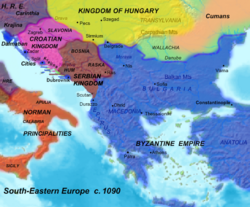
Ancient times
The first recorded settlers of present-day Montenegro were Illyrians, the Docleata. In 9 AD the Romans conquered the region. Slavs colonized the area in the 5th and 6th centuries, forming a semi-independent principality called Duklja, that was involved in Balkan medieval politics with ties to Rascia and Byzantium and to a lesser extent Bulgaria.
Middle Ages
Duklja gained its independence from the Byzantine Empire in 1042. Over the next few decades, it expanded its territory to neighbouring Rascia and Bosnia and also became recognised as a kingdom. Its power started declining at the end of the 11th century and by 1186, it was conquered by Stefan Nemanja and incorporated into Serbian realm. The newly acquired land, then called Zeta, was governed by the Serbian Nemanjić dynasty. After the Serbian Empire collapsed in the second half of the 14th century, another family (the Balšićs) came to prominence.
In 1421, it was annexed to the Serbian Despotate but after 1455 another noble family from Zeta, the Crnojevićs, ruled Montenegro until 1499, making it the last free monarchy of the Balkans before it fell to the Ottomans, who annexed it to the sanjak of Shkodër. For a short time Montenegro existed as a separate autonomous sanjak in 1514–1528, another version of which existed again between 1597 and 1614.
Ottoman rule and Metropolitanate
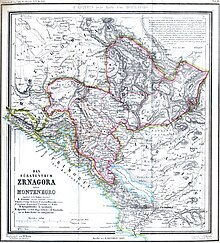
In the 16th century Montenegro developed a form of unique autonomy within the Ottoman Empire with Montenegrin clans being free from certain restrictions. Nevertheless the Montenegrins refused to accept Ottoman rule and in the 17th century raised numerous rebellions, culminating with the defeat of the Ottomans in the Great Turkish War at the end of that century.
Montenegro became a theocracy led by the Serbian Orthodox Metropolitans, flourishing since the Petrović-Njegoš became the traditional prince-bishops (whose title was "Vladika of Montenegro"). The Venetian Republic introduced governors that meddled in Montenegrin politics; when the republic was succeeded by the Austrian Empire in 1797, the governors were abolished by Prince-Bishop Petar II in 1832. His predecessor Petar I contributed to the unification of Montenegro with the Highlands.
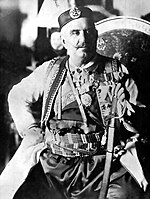
Principality of Montenegro

Under Nicholas I, the Principality was enlarged several times in the Montenegro-Turkish Wars and was recognised as independent in 1878. Under the rule of Nicholas I, diplomatic relations were established with the Ottoman Empire. Minor border skirmishes excepted, diplomacy ushered in approximately 30 years of peace between the two states until the deposition of Abdul Hamid II.
The political skills of Abdul Hamid and Nicholas I played a major role on the mutually amicable relations.[12] Modernization of the state followed, culminating with the draft of a Constitution in 1905. However, political rifts emerged between the reigning People's Party that supported the process of democratization and union with Serbia and those of the True People's Party who were monarchist.
During this period, one of the biggest in Montenegrin victories over the Ottomans occurred at the Battle of Grahovac. Grand Duke Mirko Petrović, elder brother of Knjaz Danilo, led an army of 7,500 and defeated the numerically superior Ottomans who had 13,000 troops at Grahovac on 1 May 1858. The glory of Montenegrin victory was soon immortalized in the songs and literature of all the South Slavs, in particular the Serbs in Vojvodina, then part of Austria-Hungary. This forced the Great Powers to officially demarcate the borders between Montenegro and Ottoman Empire, de facto recognizing Montenegro's independence.
The first Montenegrin constitution was proclaimed in 1855; it was also known as the Danilo Code.
Kingdom of Montenegro
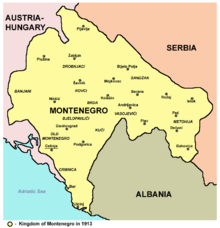
In 1910 Montenegro became a Kingdom and as a result of the Balkan wars in 1912 and 1913 (in which the Ottomans lost all Balkan land), a common border with Serbia was established, with Shkodër being awarded to a newly created Albania. In World War I in 1914 Montenegro sided with Serbia against the Central Powers, suffering a full scale defeat to Austria-Hungary in early 1916. In 1918 the Allies liberated Montenegro, which was subsequently merged with Serbia.
Unification and Christmas Uprising
During World War I (1914 – 1918) Montenegro was allied with the Allied Powers. From 15 January 1916 to some time in October 1918, Montenegro was occupied by Austria-Hungary. King Nicholas fled to Italy and then to France; the government transferred its operations to Bordeaux. When the Allies liberated Montenegro, the National Assembly of Podgorica (Podgorička skupština, Подгоричка скупштина) was convoked. The Assembly banned the King from returning, and decided to unite with the Kingdom of Serbia on December 1, 1918, although this violated the Montenegrin Constitution. A large part of the Montenegrin population rebelled in what is known as the Christmas Uprising. These rebellions, known as The Greens (Zelenaši) were against the unification with Serbia and fought against The whites (Bjelaši) who favoured unification. The military leader of the Greens was Krsto Zrnov Popović. The royal family survived in exile in France and today the head of the Royal House is Crown Prince Nicholas II who makes frequent visits to Montenegro.
Kingdom of Yugoslavia
In 1922 Montenegro formally became the Zeta Area of the Kingdom of Serbs, Croats and Slovenes, and in 1929 it became a part of a larger Zeta Banate of the Kingdom of Yugoslavia. Nikola's grandson, King Alexander Karageorgevich dominated the Yugoslav government. Zeta Banovina was one of nine bannovinas which formed the Kingdom and was named after Montenegrin medieval principality Zeta. It consisted of the present-day Montenegro and parts of Central Serbia, Croatia and Bosnia.
"Independent State of Montenegro"
In 1941, Benito Mussolini occupied Montenegro and annexed it to the Kingdom of Italy. The Queen of Italy, Elena of Montenegro influenced her husband Victor Emmanuel III to suggest that Mussolini make Montenegro independent of Yugoslavia. After the spring of 1942, much of the Sandžak region, which was included in the state of Montenegro, was not actually controlled by its government. The area of the Bay of Kotor (the venetian Cattaro) was annexed to the Dalmatian province of Italy until September 1943. After the departure of the Italians, Montenegro remained under the direct control of German troops, with a terrible and bloody guerrilla war ravaging the area. In December 1944 the German troops withdrew and Josip Broz Tito's Partisans assumed control.
Montenegro within Socialist Yugoslavia

Montenegro, like the rest of the Yugoslavia, was liberated by the Yugoslav Partisans in 1944. The first uprising in Axis-occupied Europe happened on 13 July 1941 in Montenegro,[13] when Montenegrins stood up against the fascists and joined Communist partisans. Notable Partisans from Montenegro include Arso Jovanovic, Sava Kovacevic, Svetozar Vukmanovic-Tempo, Milovan Djilas, Peko Dapcevic, Vlado Dapcevic, Veljko Vlahovic, Blazo Jovanovic and Ivan Milutinovic. Montenegro became a constituent of the six republics of the communist Socialist Federal Republic of Yugoslavia (SFRY), its capital became Podgorica renamed Titograd in honour of President Josip Broz Tito. After the war, the infrastructure of Yugoslavia was rebuilt, industrialization began and the University of Montenegro was established. Greater autonomy was established until the Socialist Republic of Montenegro ratified a new constitution 1974.
Dissolution of Socialist Yugoslavia and forming of FR Yugoslavia
After the dissolution of the SFRY in 1992, Montenegro remained part of a smaller Federal Republic of Yugoslavia along with Serbia.
In the referendum on remaining in Yugoslavia in 1992, the turnout was 66% with 95.96% of the votes cast in favour the federation with Serbia. The referendum was boycotted by the Muslim, Albanian and Catholic minorities as well as the pro-independence Montenegrins. The opponents claimed that the poll was organized under anti-democratic conditions with widespread propaganda from the state-controlled media in favour of a pro-federation vote. There is no impartial report on the fairness of the referendum, as it was unmonitored, unlike in 2006 when European Union observers were present.
During the 1991–1995 Bosnian War and Croatian War, Montenegrin police and military forces joined Serbian troops in the attacks on Dubrovnik, Croatia.[14] These acts of aggression, aimed at acquiring more territory, were characterized by a consistent pattern of gross and systematic violation of human rights.[15]
Montenegrin General Pavle Strugar was convicted for his part in the bombing of Dubrovnik.[16] Bosnian refugees were arrested by Montenegrin police and transported to Serb camps in Foča, where they were subjected to systematic torture and executed.[17][18]
In 1996, Milo Đukanović's government severed ties between Montenegro and the Serbian regime, which was then under Slobodan Milošević. Montenegro formed its own economic policy and adopted the German Deutsche Mark as its currency and subsequently adopted the Euro, although not part of the Eurozone currency union. Subsequent governments have pursued pro-independence policies and political tensions with Serbia simmered despite the political changes in Belgrade. Targets in Montenegro were bombed by NATO forces during Operation Allied Force in 1999, although the extent of these attacks was very limited in both time and area affected.[19]
In 2002, Serbia and Montenegro came to a new agreement regarding continued cooperation and entered into negotiations regarding the future status of the Federal Republic of Yugoslavia. In 2003, the Yugoslav federation was replaced in favour of a more decentralized state union named Serbia and Montenegro.
Independence

The status of the union between Montenegro and Serbia was decided by the referendum on Montenegrin independence on 21 May 2006. A total of 419,240 votes were cast, representing 86.5% of the total electorate. 230,661 votes (55.5%) were for independence and 185,002 votes (44.5%) were against.[20] The 45,659 difference narrowly surpassed the 55% threshold needed to validate the referendum under the rules set by the European Union. According to the electoral commission, the 55% threshold was passed by only 2,300 votes. Serbia, the member-states of the European Union, and the permanent members of the United Nations Security Council all recognised Montenegro's independence.
The 2006 referendum was monitored by five international observer missions, headed by an OSCE/ODIHR team, and around 3,000 observers in total (including domestic observers from CEMI, CEDEM and other organizations). The OSCE/ODIHR joined efforts with the observers of the OSCE Parliamentary Assembly (OSCE PA), the Parliamentary Assembly of the Council of Europe (PACE), the Congress of Local and Regional Authorities of the Council of Europe (CLRAE) and the European Parliament (EP) to form an International Referendum Observation Mission (IROM). The IROM—in its preliminary report—"assessed compliance of the referendum process with OSCE commitments, Council of Europe commitments, other international standards for democratic electoral processes, and domestic legislation." Furthermore, the report assessed that the competitive pre-referendum environment was marked by an active and generally peaceful campaign and that "there were no reports of restrictions on fundamental civil and political rights."
On 3 June 2006, the Montenegrin Parliament declared the independence of Montenegro,[21] formally confirming the result of the referendum. Serbia did not object to the declaration.
Relations between Serbia and Montenegro were strained on 6 September 2007 after Montenegro banned Serbian Orthodox Church leader Bishop Filaret from entering the country. Tension escalated when an adviser to the Serbian prime minister referred to Montenegro as a "quasi-state", prompting Podgorica to seek an apology and lodge a protest with Serbia's government.[22] The Deputy Prime Minister of Serbia, Božidar Đelić, sent a note of apology to Montenegro following the statement made by Serbian Premier's Aide Aleksandar Simic.[23][24]
Geography
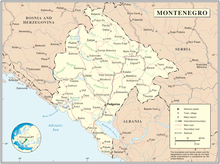

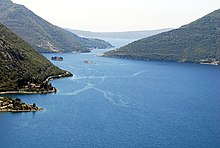
Internationally, Montenegro borders Croatia, Bosnia and Herzegovina, Serbia, Kosovo, and Albania. It lies between latitudes 41° and 44° N, and longitudes 18° and 21° E.
Historically, its territory was divided into "nahije". Template:Montenegro city
Montenegro ranges from high peaks along its borders with Serbia and Albania, a segment of the Karst of the western Balkan Peninsula, to a narrow coastal plain that is only one to four miles (6 km) wide. The plain stops abruptly in the north, where Mount Lovćen and Mount Orjen plunge into the inlet of the Bay of Kotor.
Montenegro's large Karst region lies generally at elevations of 1,000 metres (3,280 ft) above sea level; some parts, however, rise to 2,000 m (6,560 ft), such as Mount Orjen (1,894 m (6,214 ft)*), the highest massif among the coastal limestone ranges. The Zeta River valley, at an elevation of 500 m (1,600 ft), is the lowest segment.
The mountains of Montenegro include some of the most rugged terrain in Europe, averaging more than 2,000 metres in elevation. One of the country's notable peaks is Bobotov Kuk in the Durmitor mountains, which reaches a height of 2,522 metres (8,274 ft). The Montenegrin mountain ranges were among the most ice-eroded parts of the Balkan Peninsula during the last glacial period.
- Longest beach: Velika Plaža, Ulcinj — 13,000 m (8.1 mi)
- Highest peak: Zla Kolata, Prokletije at 2,534 m
- Largest lake: Skadar Lake — 391 km2 (151 sq mi) of surface area
- Deepest canyon: Tara River Canyon — 1,300 m (4,300 ft)
- Biggest bay: Bay of Kotor
- National parks: Durmitor — 390 km2 (150 sq mi), Lovćen — 64 km2 (25 sq mi), Biogradska Gora — 54 km2 (21 sq mi), Skadar Lake — 400 km2 (154 sq mi)
- UNESCO World Heritage sites: Durmitor and Tara River Canyon, old city of Kotor.
Government and politics

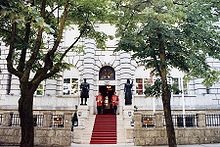
The Constitution of Montenegro describes the state as a "civic, democratic, ecological state of social justice, based on the reign of Law."[25] Montenegro is an independent and sovereign republic that proclaimed its new constitution on 22 October 2007.

The President of Montenegro (Montenegrin: Predsjednik Crne Gore) is the head of state, elected for a period of five years through direct elections. The President represents the republic abroad, promulgates laws by ordinance, calls elections for the Parliament, proposes candidates for Prime Minister, president and justices of the Constitutional Court to the Parliament. The President also proposes the calling of a referendum to Parliameny, grants amnesty for criminal offences prescribed by the national law, confers decoration and awards and performs other constitutional duties and is a member of the Supreme Defence Council. The official residence of the President is in Cetinje.
The Government of Montenegro (Montenegrin: Vlada Crne Gore) is the executive branch of government authority of Montenegro. The government is headed by the Prime Minister, and consists of the deputy prime ministers as well as ministers.
The Parliament of Montenegro (Montenegrin: Skupština Crne Gore) is a unicameral legislative body. It passes laws, ratifies treaties, appoints the Prime Minister, ministers, and justices of all courts, adopts the budget and performs other duties as established by the Constitution. Parliament can pass a vote of no-confidence on the Government by a simple majority. One representative is elected per 6,000 voters. The present parliament contains 81 seats, with a 47-seat majority currently held by the Coalition for a European Montenegro as a result of the 2009 parliamentary election.
Symbols
A official flag of Montenegro, based on the royal standard of King Nikola I was adopted on 12 July 2004 by the Montenegrin legislature. This royal flag was red with a silver border, a silver coat of arms, and the initials НІ in Cyrillic script (corresponding to NI in Latin script) representing King Nikola I. On the current flag, the border and arms are in gold and the royal cipher in the centre of the arms was replaced with a golden lion.
The national day of 13 July marks the date in 1878 when the Congress of Berlin recognized Montenegro as the 27th independent state in the world[26] and the start of one of the first popular uprisings in Europe against the Axis Powers on 13 July 1941 in Montenegro.
In 2004, the Montenegrin legislature selected a popular Montenegrin traditional song, Oh, Bright Dawn of May, as the national anthem. Montenegro's official anthem during the reign of King Nikola was Ubavoj nam Crnoj Gori (To our beautiful Montenegro).
Administrative subdivisions
Montenegro is divided into twenty-one municipalities (opština), and two urban municipalities, subdivisions of Podgorica municipality:
Military
The Military of Montenegro is composed of an army, navy, air force, and a special forces component. As of 2009 it is organized as a fully professional standing army under the Ministry of Defence with the aim of protecting and defending Montenegro sovereignty. Montenegro's goal is to eventually join NATO after modernization and reorganization of its military.[27] Future plans for the army are to participate in peacekeeping missions through various United Nations and NATO efforts such as the International Security Assistance Force.[28]
Economy
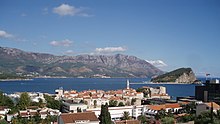
The economy of Montenegro is mostly service-based and is in late transition to a market economy. According to the International Monetary Fund, the nominal GDP of Montenegro was $4.114 billion in 2009. The GDP PPP for 2009 was $6.916 billion, or $11,048 per capita.[29]
GDP grew at an impressive 10.7% in 2007 and 7.5% in 2008.[29] The country entered a recession in 2008 as a part of the global recession, with GDP contracting by 4%. However, Montenegro remained a target for foreign investment, the only country in the Balkans to increase its amount of direct foreign investment.[30] The country is expected to exit the recession in mid-2010, with GDP growth predicted at around 0.5%.[31] However, the significant dependence of the Montenegrin economy on foreign direct investment leaves it susceptible to external shocks and a high export/import trade deficit.
In 2007, the service sector made up for 72.4% of GDP, with industry and agriculture making up the rest at 17.6% and 10%, respectively.[32]
According to Eurostat data, the Montenegrin GDP per capita stood at 46% of the EU average in 2008.[33]
Aluminum and steel production and agricultural processing make up for most of the industrial output.
Tourism is an important contributor to Montenegrin economy. Approximately one million tourists visited Montenegro in 2007, resulting in €480 million of tourism revenue. Tourism is considered the backbone of future economic growth, and government expenditures on infrastructure improvements are largely target towards that goal.
Infrastructure
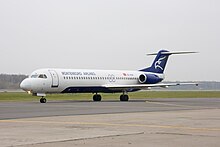
The Montenegrin road infrastructure is not on par with European standards. Despite an extensive road network, no roads are built to full motorway standards. Construction of new motorways is considered a national priority, as they are important for uniform regional economic development and the development of Montenegro as an elite tourist destination.
Current European routes that pass through Montenegro are E65 and E80.
The backbone of the Montenegrin rail network is the Belgrade - Bar railway. This railway intersects with Nikšić - Tirana(Albania) at Podgorica; however, it is not used for passenger service.
Montenegro has two international airports, Podgorica Airport and Tivat Airport. The two airports served 1.1 million passengers in 2008. Montenegro Airlines is the flag carrier of Montenegro.
The Port of Bar is Montenegro's main seaport. Initially built in 1906, the port was almost completely destroyed during World War II, with reconstruction beginning in 1950. Today, it is equipped to handle over 5 million tons of cargo annually, though the breakup of the former Yugoslavia and the size of the Montenegrin industrial sector has resulted in the port operating at a loss and well below capacity for several years. The reconstruction of the Belgrade-Bar railway and the proposed Belgrade-Bar motorway are expected to bring the port back up to capacity.
Tourism
Montenegro has both a picturesque coast and a mountainous northern region. The country was a well-known tourist spot in the 1980s. Yet, the Yugoslav wars that were fought in neighbouring countries during the 1990s crippled the tourist industry and destroyed the image of Montenegro as a tourist destination.
The Montenegrin Adriatic coast is 295 km (183 mi) long, with 72 km (45 mi) of beaches, and with many well-preserved ancient old towns. National Geographic Traveler (edited once in decade) features Montenegro among the "50 Places of a Lifetime", and Montenegrin seaside Sveti Stefan was used as the cover for the magazine.[34] The coast region of Montenegro is considered one of the great new "discoveries" among world tourists. In January 2010, The New York Times ranked the Ulcinj South Coast region of Montenegro, including Velika Plaza, Ada Bojana, and the Hotel Mediteran of Ulcinj, as among the "Top 31 Places to Go in 2010" as part of a worldwide ranking of tourism destinations.[35] Montenegro was also listed in "10 Top Hot Spots of 2009" to visit by Yahoo Travel, describing it as "Currently ranked as the second fastest growing tourism market in the world (falling just behind China)".[36] It is listed every year by prestigious tourism guides like Lonely Planet as top touristic destination along with Greece, Spain and other world touristic places[37][38]
It was not until the 2000s that the tourism industry began to recover, and the country has since experienced a high rate of growth in the number of visits and overnight stays. The Government of Montenegro has set the development of Montenegro as an elite tourist destination a top priority. It is a national strategy to make tourism a major contributor to the Montenegrin economy. A number of steps were taken to attract foreign investors. Some large projects are already under way, such as Porto Montenegro, while other locations, like Jaz Beach, Buljarica, Velika Plaža and Ada Bojana, have perhaps the greatest potential to attract future investments and become premium tourist spots on the Adriatic.
-
Miriste Beach, Herceg Novi
-
The Church of Our Lady of the Rocks, an example of Roman Catholic architecture in Montenegro.
-
View of Budva
-
The Castle of Ulcinj
-
A view of Sveti Stefan island in the Budva municipality.
-
Biogradska Gora, one of the few remaining European rain forests and a national park in Kolašin.
-
Tara River Canyon, longest canyon in Europe and the second-longest in the world.
Demographics
This article needs additional citations for verification. (January 2010) |

Ethnicity
According to the 2003 census, Montenegro has 620,145 citizens. If the methodology used up to 1991 had been adopted in the 2003 census, Montenegro would officially have recorded 673,094 citizens. Most recent estimates stake somewhere below 700,000 inhabitants.
When the census was taken Montenegro was a non-national civic state. In the meantime, the Constitution was changed, hence it now recognizes the major ethnic groups: Montenegrins, Serbs, Bosniaks, Muslims, Albanians and Croats. Thus, the number of "Montenegrins" and "Serbs" fluctuates wildly from census to census due to changes in how people experience their identity.[39] The Petrović dynasty of outlanders deferred to their "Serbian ethnicity" (due to their bosnian origin), their subjective opinion was that the populace was Montenegrin in nationality, it was distinctly "Serbian in ethnicity". This tension or confusion continues to this day (ethnicity vs nationality). Montenegrin Prince Danilo Petrovic Njegos mistakenly observed: "...there is no other ethnicity in this land except 'Serb ethnicity'...", Code of Montenegro and The Highlands established in 1855.[40] There have been voluminous works done regarding the so called "Serbian origins" of the Montenegrin state including the comprehensive work authoured by Petar Vlahovic in "The Serbian origin of the Montenegrins" [41] Further historical works examining the "Serbian footprint" in Montenegro can be found at http://www.njegos.org/siteindex/ethnic.htm
In 1945 president Tito’s communist regime began program of liberation of Montenegrin people from Serb hegemony and assimilation. Of course, Serb hegemonists never accepted the fact that Montenegrins were never Serbs but an independent nation and ethnicity. In his academic paper, Montenegrin Dr. Terzic, of the Historical Institute of the Serbian Academy of Sciences and Arts notes that: “Montenegrin separate national ethnic identity was proclaimed by Tito's Communist regime in 1945 through the words: “Montenegrins are different Serbs than other Serbs”). Serb clero-fascism was based on old strategy of destruction of Montenegrin ethnical, cultural and spiritual independence. Through entire Montenegrin history, Montenegrins have never considered themselves as ethnic Serbs by nationality.
Ethnic composition according to the 2004 official data:[42]
| Number | % | |
| TOTAL | 620,145 | 100 |
| Montenegrins | 267,669 | 43.16 |
| Serbs | 198,414 | 31.99 |
| Bosniaks | 48,184 | 7.77 |
| Ethnic Muslims | 36,479 | 3.97 |
| Albanians | 24,163 | 5.03 |
| Croats | 6,811 | 1.1 |
| Roma | 2,601 | 0.42 |
| Yugoslavs | 1,860 | 0.3 |
| Italians | 500 | 0.08 |
| others | 38,818 | 6.18 |
According the newest report, there are 24,610 total refugees from the Yugoslav wars in Montenegro, forming 4.2% of the total population.
Language

Most citizens speak the Serbian language of the Iyekavian dialect. However, as of 2004 moves for an independent Montenegrin language were promoted and with the new 2007 Constitution it became Montenegro's prime official language. Next to it, Serbian, Bosnian, Albanian and Croatian are recognized in usage. All of these languages except for Albanian are virtually identical in common usage.
| Number | % | |
| TOTAL | 620,145 | 100 |
| Serbian | 393,740 | 63.49 |
| Montenegrin | 136,208 | 21.96 |
| Bosnian/Bosniac | 34,078 | 5.49 |
| Albanian | 32,603 | 5.26 |
| Croatian | 2,791 | 0.45 |
| Italian | 500 | 0.08 |
| other | 20,725 | 3.26 |
Religion

Most Montenegrin inhabitants are Orthodox Christians, followers of the Serbian Orthodox Church's Metropolitanate of Montenegro and the Littoral and the Montenegrin Orthodox Church. The religious institutions all have guaranteed rights and are separate from the state. There is a sizeable number of Sunni Muslims Montenegrins that maintain their own Islamic Community of Montenegro. There is also a small Roman Catholic population, divided between the Archdiocese of Antivari headed by Primate of Serbia and the Diocese of Kotor that is a part of the Church of Croatia. Religious determination according to the census:
| Number | % | |
| TOTAL | 620,145 | 100 |
| Orthodox | 460,383 | 74.24 |
| Muslim | 110,034 | 17.74 |
| Roman Catholic | 21,972 | 3.54 |
| other | 27,756 | 4.48 |
Education
Education in Montenegro is regulated by the Montenegrin Ministry of Education and Science.
Education starts in either pre-schools or elementary schools. Children enroll in elementary schools (Montenegrin: Osnovna škola) at the age of 6; it lasts 9 years. The students may continue their secondary education (Montenegrin: Srednja škola), which lasts 4 years (3 years for trade schools) and ends with graduation (Matura). Higher education lasts with a certain first degree after 3 to 6 years. There is one public University (University of Montenegro and two private (University "Mediterranean" and UDG).
Elementary education
Elementary education in Montenegro is free and compulsory for all the children between the ages of 6 and 14.
Secondary education
Secondary schools are divided in three types, and children attend one depending on choice and primary school grades:
- Gymnasium (Gimnazija), lasts for four years and offers a general, broad education. It is a preparatory school for university, and hence the most academic and prestigious.
- Professional schools (Stručna škola) last for three or four years and specialize students in certain fields which may result in them attending college; professional schools offer a relatively broad education.
- Vocational schools (Zanatska škola) last for three years and focus on vocational education (e.g., joinery, plumbing, mechanics) without an option of continuing education after three years.
Tertiary education
Tertiary level institutions are divided into "Higher education" (Više obrazovanje) and "High education" (Visoko obrazovanje) level faculties.
- Colleges (Fakultet) and art academies (akademija umjetnosti) last between 4 and 6 years (one year is two semesters long) and award diplomas equivalent to a Bachelor of Arts or a Bachelor of Science degree.
Higher schools (Viša škola) lasts between two and four years.
Post-graduate education
Post-graduate education (post-diplomske studije) is offered after tertiary level and offers Masters' degrees, Ph.D. and specialization education.
Culture
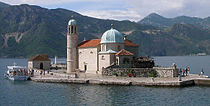

The culture of Montenegro has been shaped by a variety of influences throughout history. The influence of Orthodox, Slavonic, Central European, Islamic, and seafaring Adriatic cultures (notably parts of Italy, like the Republic of Venice) have been the most important in recent centuries.
Montenegro has many significant cultural and historical sites, including heritage sites from the pre-Romanesque, Gothic and Baroque periods. The Montenegrin coastal region is especially well known for its religious monuments, including the Cathedral of Saint Tryphon in Kotor[43] (Cattaro under the Venetians), the basilica of St. Luke (over 800 years), Our Lady of the Rocks (Škrpjela), the Savina Monastery and others. Montenegro's medieval monasteries contain thousands of square metres of frescos on their walls.
The traditional folk dance of the Montenegrins is the Oro, a circle dance that involves dancers standing on each other's shoulders in a circle while one or two dancers are dancing in the middle.
The first literary works written in the region are ten centuries old, and the first Montenegrin book was printed five hundred years ago. The first state-owned printing press was located in Cetinje in 1494, where the first South Slavic book, Oktoih, was printed the same year. Ancient manuscripts, dating from the thirteenth century, are kept in the Montenegrin monasteries.[44]
Montenegro's capital Podgorica and the former royal capital of Cetinje are the two most important centers of culture and the arts in the country.
Ethical beliefs
A very important dimension of Montenegrin culture is the ethical ideal of Čojstvo i Junaštvo, "Humanity and Gallantry".[45][46]
Sport
The Sport in Montenegro revolves mostly around team sports: football, basketball, water polo, volleyball and handball. Also involved are boxing, judo, karate, athletics, table tennis, and chess. The main football club in Montenegro is FK Budućnost Podgorica from capital Podgorica.[47] Montenegro hosted together with Serbia EuroBasket 2005.[48] Previously, all National Teams were known as Yugoslavian national teams, as Montenegro was part of Yugoslavia. On 24 March 2007, the Montenegrin national team came from behind to win its first ever fixture, 2-1, in a friendly game against Hungary at the Podgorica Stadium.[49] On their 119th Session in Guatemala City in July 2007, the International Olympic Committee granted recognition and membership to the newly formed Montenegrin National Olympic Committee. Montenegro made its debut at the 2008 Summer Olympics in Beijing.[50]
Water polo is one of the most popular sports in the country. Montenegro won the European Championships in Malaga, Spain on 13 July 2008 over Serbia 6-5 in a game that was tied 5-5 after four quarters.[51] This was Montenegro's first major international competition for which they had to qualify through two LEN tournaments. Montenegro won the gold medal at the 2009 FINA Men's Water Polo World League which was held in Podgorica.[52] Montenegrin team PVK Primorac from Kotor became a champion of Europe at the LEN Euroleague 2009 in Rijeka, Croatia. Montenegro’s first division in water polo consists of six clubs, four of them with an annual budget of one million Euros and more — VK Primorac Kotor (2007 and 2008 Montenegro champions), VK Jadran Herceg Novi (2006 champions of Serbia-Montenegro), VK Budvanska Rivijera Budva, VK Cattaro. Montenegro's water polo Olympic team finished fourth overall at the 2008 Olympic Games in Beijing.
Cuisine
Montenegrin cuisine is a result of Montenegro's long history. It's variation of Mediterranean and Oriental. The most influence is from Italy, Turkey, Byzantine Empire/Greece, and as well from Hungary. Montenegrin cuisine also varies geographically; the cuisine in the coastal area differs from the one in the northern highland region. The coastal area is traditionally a representative of Mediterranean cuisine, with seafood being a common dish, while the northern represents more the Oriental.
In popular culture
This article contains a list of miscellaneous information. (February 2010) |
The first official international representation of Montenegro as an independent state was in Miss World 2006, held on 30 September 2006 in Warsaw, Poland. Ivana Knežević from the city of Bar was the first Miss Montenegro at any international beauty pageant.[53] Both Montenegro and Serbia competed separately in this pageant for the first time after the state union came to an end.
Part of the 2006 James Bond film Casino Royale is set in Montenegro,[54] although most of the filming was done in the Czech Republic.
Nero Wolfe, the eccentric fictional detective created by American writer Rex Stout, is Montenegrin by birth.[55] One Nero Wolfe novel, The Black Mountain, takes place in Tito-era Montenegro.
Largo Winch, a popular comic book character, was born in Socialist Republic of Montenegro, then part of SFRY.
Jay Gatsby, the main character of the F. Scott Fitzgerald novel The Great Gatsby, said he was given a medal of honour by the Montenegrin King Nicholas I.
The setting for Franz Lehár's 1905 operetta The Merry Widow is the Paris embassy of the Grand Duchy of Pontevedro. Pontevedro is a fictionalized version of Montenegro and several of the characters were loosely based on actual Montenegrin nobility.
A Corto Maltese novel, "The Celts", features the chapter "Under The Flag Of Money" revolving around a group of people led by Maltese trying to seize the treasure of King Nicholas I from a small village in Italy during the Battle of Caporetto. At the end of the chapter it is revealed that Corto plans to disembark in Ulcinj with half of the treasure.
Montenegrin holidays
| Date | Name | Notes |
|---|---|---|
| 1 January | New Year's Day | (non-working holiday) |
| 7 January | Orthodox Christmas | (non-working) |
| 2 April | Orthodox Good Friday | Date for 2010 only |
| 4 April | Orthodox Easter | Date for 2010 only |
| 5 April | Orthodox Easter Monday | Date for 2010 only |
| 1 May | Labor Day | (non-working) |
| 9 May | Victory Day | |
| 21 May | Independence Day | (non-working) |
| 13 July | Statehood Day | (non-working) |
See also
Column-generating template families
The templates listed here are not interchangeable. For example, using {{col-float}} with {{col-end}} instead of {{col-float-end}} would leave a <div>...</div> open, potentially harming any subsequent formatting.
| Type | Family | Handles wiki
table code?† |
Responsive/ mobile suited |
Start template | Column divider | End template |
|---|---|---|---|---|---|---|
| Float | "col-float" | Yes | Yes | {{col-float}} | {{col-float-break}} | {{col-float-end}} |
| "columns-start" | Yes | Yes | {{columns-start}} | {{column}} | {{columns-end}} | |
| Columns | "div col" | Yes | Yes | {{div col}} | – | {{div col end}} |
| "columns-list" | No | Yes | {{columns-list}} (wraps div col) | – | – | |
| Flexbox | "flex columns" | No | Yes | {{flex columns}} | – | – |
| Table | "col" | Yes | No | {{col-begin}}, {{col-begin-fixed}} or {{col-begin-small}} |
{{col-break}} or {{col-2}} .. {{col-5}} |
{{col-end}} |
† Can template handle the basic wiki markup {| | || |- |} used to create tables? If not, special templates that produce these elements (such as {{(!}}, {{!}}, {{!!}}, {{!-}}, {{!)}})—or HTML tags (<table>...</table>, <tr>...</tr>, etc.)—need to be used instead.
References
- ^ CIA World Factbook: Montenegro
- ^ a b c "Montenegro". International Monetary Fund. Retrieved 2011-01-13.
- ^ "Human Development Report 2010" (PDF). United Nations. 2010. Retrieved 5 November 2010.
- ^ "Google Maps". Maps.google.co.uk. 1970-01-01. Retrieved 2010-09-11.
- ^ Basic data of Montenegro[dead link]
- ^ "Montenegro.org". Montenegro.org. Retrieved 2010-09-11.
- ^ "Montenegro.org". Montenegro.org. 1997-04-24. Retrieved 2010-09-11.
- ^ Crna Gora od danas kandidat.
- ^ pcnen.com. "Crna Gora u predvorju NATO-a". Pcnen.com. Retrieved 2010-09-11.
- ^ This literal translation is used in Mainland China and Hong Kong; Taiwanese Mandarin uses 蒙特內哥羅 "Méngtènèigēluó", a phonetic transcription of "Montenegro"
- ^ ISO 3166-1 Newsletter No. V-12, Date: 2006-09-26
- ^ Uğur Özcan, II. Abdülahmid Dönemi Osmanlı Karadağ Siyasi İlişkileri (Political relations between the Ottoman Empire and Montenegro in the Abdul Hamid II era)Dissertation Thesis, Suleyman Demirel University Institute of Social Science, Isparta 2009
- ^ "Prema oceni istoričara, Trinaestojulski ustanak bio je prvi i najmasovniji oružani otpor u porobljenoj Evropi 1941. godine."
- ^ "Croatiatraveller.com". Croatiatraveller.com. Retrieved 2010-09-11.
- ^ "UN.org". UN.org. Retrieved 2010-09-11.
- ^ YIHR.org[dead link]
- ^ "UWE.ac.uk". Ess.uwe.ac.uk. Retrieved 2010-09-11.
- ^ "Porodica Nedžiba Loje o Njegovom Hapšenju i Deportaciji 1992". Godine Bosnjaci.net
- ^ "Russia pushes peace plan". BBC. 1999-04-29.
- ^ "Montenegro vote result confirmed". BBC News. 2006-05-23. Retrieved 2010-09-11.
- ^ "Montenegro declares independence". BBC News. 2006-06-04. Retrieved 2010-09-11.
- ^ english@peopledaily.com.cn (2007-09-08). "People.com.cn". People.com.cn. Retrieved 2010-09-11.
- ^ "MFA.gov.rs". MFA.gov.rs. Retrieved 2010-09-11.
- ^ "Crna Gora tražila javno izvinjenje zbog afere "kvazidržava"". Vijesti.[dead link]
- ^ "Ustav Crne Gore" (PDF). Retrieved 2010-09-11.
- ^ "President Vujanovic's Closing Speech at the Crans Montana Forum". Predsjednik.me. 2006-02-21. Retrieved 2010-09-11.
- ^ "Cilj Crne Gore članstvo u NATO". Pobjeda.me. 2008-04-30. Retrieved 2010-09-11.
- ^ "Spremaju se za Avganistan". Vijesti.me. Retrieved 2010-09-11.
- ^ a b "5. Report for Selected Countries and Subjects". April 2009.
- ^ FDI falls across West Balkans, except Montenegro. Reuters India 10 December 2009. Retrieved 14 December 2009.
- ^ Montenegro's leader sees slow economic recovery. Balkans.com Business News 9 December 2009. Retrieved 14 December 2009.
- ^ "Montenegro at a glance" (PDF).
- ^ "GDP per capita in PPS" (PDF). Eurostat. Retrieved 2009-06-25.
- ^ "50 Places of a Lifetime". Blogs.nationalgeographic.com. 2009-09-17. Retrieved 2010-09-11.
- ^ "The 31 Places to Go in 2010" - New York Times
- ^ "10 Top Hot Spots of 2009 by Yahoo Travel". Travel.yahoo.com. Retrieved 2010-09-11.
- ^ Holger Leue. "Where to go in June". Lonely Planet. Retrieved 2010-09-11.
- ^ "America Sending their Best Adventure Racers to Montenegro". Adventureworldmagazineonline.com. 2010-06-04. Retrieved 2010-09-11.
- ^ "Montenegrin Census' from 1909 to 2003". Njegos.org. 2004-09-23. Retrieved 2010-09-11.
- ^ "The Code of Prince Danilo". Njegos.org. 2004-04-23. Retrieved 2011-01-20.
- ^ "The Serbian origin of the Montenegrins". Njegos.org. 2004-04-23. Retrieved 2011-01-20.
- ^ "Official results of the 2003 Montenegrin census". Statistical office of Montenegro. Retrieved 2010-05-27. [dead link]
- ^ Aleksandar Šestović. "Kotor". Kotoronline.com. Retrieved 2010-09-11.
- ^ Milan Nikolic. "History of Montenegro: Crnojevic Rule". Montenet. Retrieved 2010-09-11.
- ^ "Чојство и јунаштво старих Црногораца, Цетиње 1968. 3-11". Web.f.bg.ac.rs. Retrieved 2010-09-11.
- ^ Oblikovanje crnogorske nacije u doba petrovica njegosa, "Cojstvo je osobeno svojstvo Crnogoraca, koje su uzdigli u najvecu vrlinu i uzor."[dead link]
- ^ "Budućnost uz velikane". Fkbuducnost.co.me. Retrieved 2010-09-11.
- ^ "EuroBasket History — The 21st Century". Eurobasket2009.org. Retrieved 2010-09-11.
- ^ Montenegro take a bow at victory[dead link]
- ^ "Podignuta crnogorska zastava u olimpijskom selu". Cokcg.org. Retrieved 2010-09-11.
- ^ Radio-televizija Vojvodine, www.rtv.rs. "Crna Gora šampion Evrope". Rtv.rs. Retrieved 2010-09-11.
- ^ Montenegro Wins World League[dead link]
- ^ "Warsaw (MissWorld-2006-Warsaw". Sfmission.com. Retrieved 2010-09-11.
- ^ Sonypictures.com, James Bond Casino Royal official web site, "About"
- ^ McAleer, John, Rex Stout: A Biography, 1977, Little, Brown and Company; ISBN 0-316-55340-9 pp. 403, 556, 566
| a. | ^ Template:Kosovo-note |
Further reading
- Realm of the Black Mountain: A History of Montenegro by Elizabeth Roberts (Hurst & Co, 2007) ISBN 978-1-85065-868-9
- Montenegro: The Divided Land by Thomas Fleming (2002) ISBN 0-9619364-9-5
- The Rough Guide to Montenegro by Norm Longley (2009) ISBN 978-1-85828-771-3
- The National Question in Yugoslavia: Origins, History, Politics Cornell University Press, by Ivo Banac (1984) ISBN 0-8014-9493-1
- A History of Montenegro by Francis Seymour Stevenson (2002) ISBN 978-1-4212-5089-2
- Montenegro: A Modern History by Kenneth Morrison (2009) ISBN 978-1-84511-710-8
- II. Abdulhamid Dönemi Osmanlı Karadağ Siyasi İlişkileri [Political relations between the Ottoman Empire and Montenegro in the Abdul Hamid II era] by Uğur Özcan (2009) Phd. Dissertation Thesis, Suleyman Demirel University Institute of Social Science, Isparta 2009
External links
- Ill-formatted IPAc-en transclusions
- Articles with trivia sections from February 2010
- World Heritage Sites in Montenegro
- Montenegro
- Countries of the Mediterranean Sea
- European countries
- Slavic countries
- Serbo-Croatian-speaking countries
- Republics
- Liberal democracies
- States and territories established in 2006
- Balkans
- Member states of the Union for the Mediterranean












